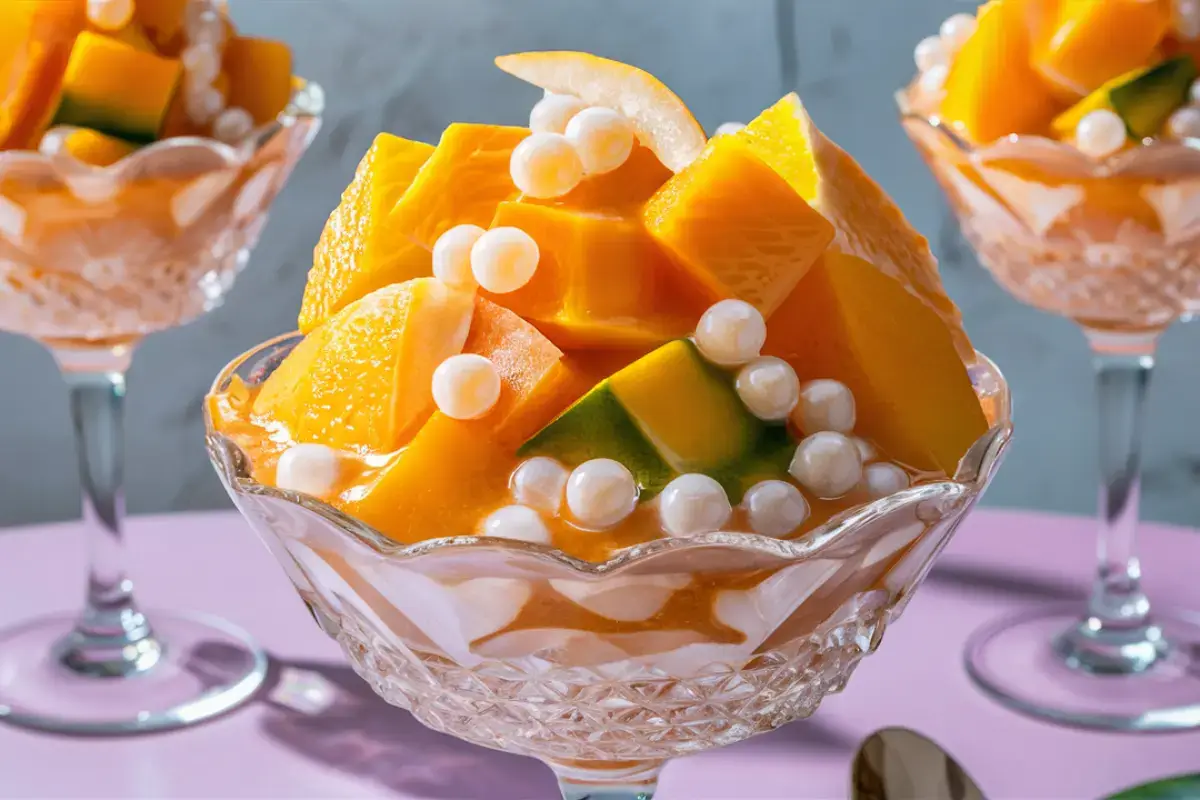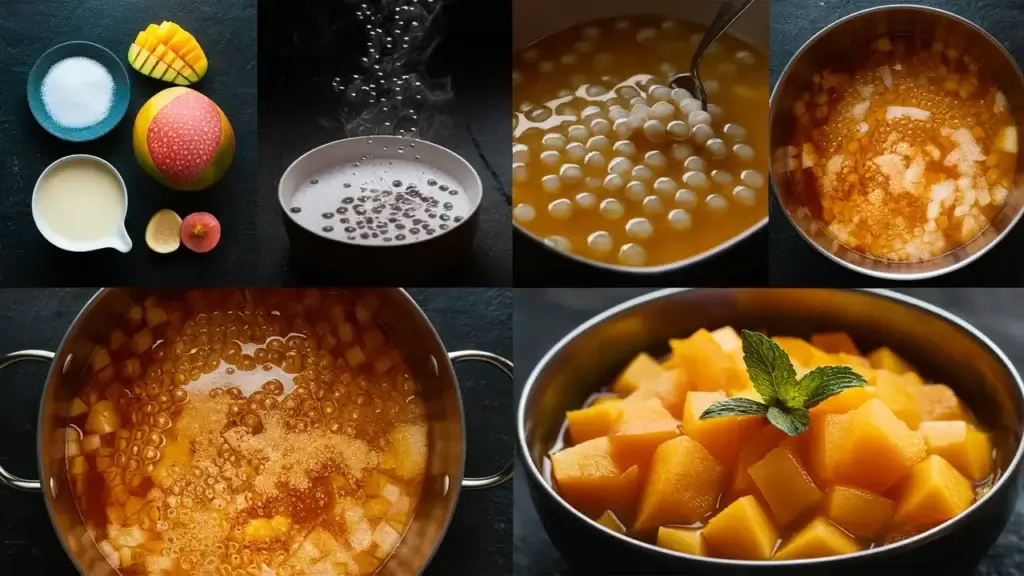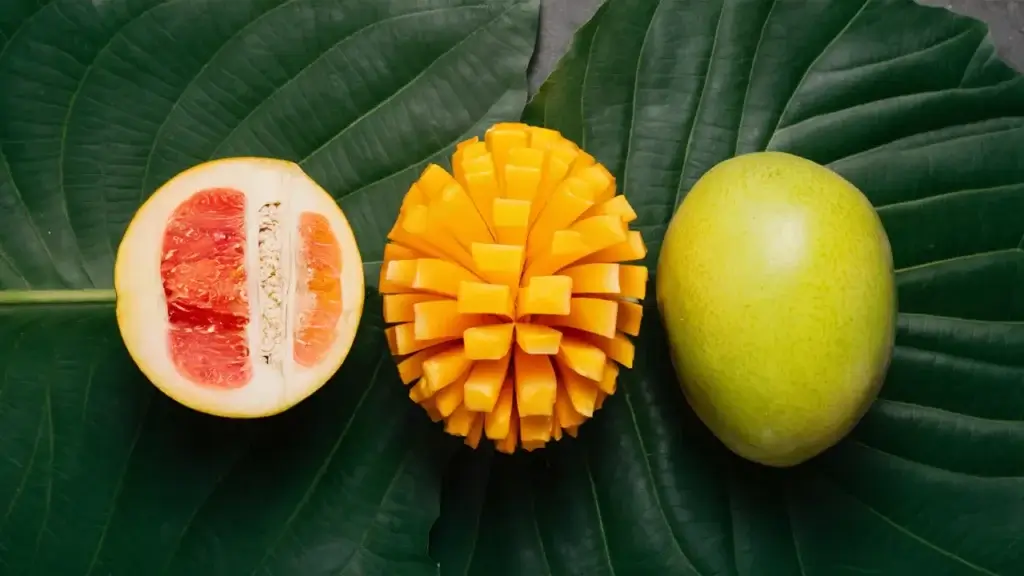Mango Pomelo Sago is a refreshing dessert that has captured the hearts of many with its creamy, fruity, and mildly tart flavor profile. Originating from Hong Kong, this dessert has become a staple in many Chinese and Southeast Asian restaurants. The combination of juicy mangoes, tangy pomelo, and soft sago pearls in a luscious coconut milk base makes it the perfect treat for any occasion, especially during the warmer months.
A Brief History of Mango Pomelo Sago
Mango Pomelo Sago was first created in the late 1980s by a chef in Hong Kong. The dessert was originally served as a signature dish at Lei Garden, a renowned Cantonese restaurant. Since then, it has grown in popularity, spreading across Asia and even making its way to Western countries. The dessert is loved for its unique combination of textures and flavors, offering a modern twist on traditional Asian dessert elements.
Why Mango Pomelo Sago?
This dessert is a true embodiment of tropical flavors, offering a balance of sweetness, tartness, and creaminess that few desserts can match. Here’s why it deserves a place in your culinary repertoire:
- Exotic Flavors: The blend of mango and pomelo offers a taste of the tropics, while the coconut milk adds a rich, creamy base.
- Texture Contrast: The chewiness of the sago pearls contrasts beautifully with the smoothness of the mango and the slight crunch of the pomelo.
- Nutritional Benefits: Mangoes are rich in vitamins A and C, pomelos are packed with antioxidants, and sago provides a good source of carbohydrates.
- Visual Appeal: The vibrant colors of mango and pomelo make this dessert as beautiful to look at as it is to eat.
Ingredients Breakdown
Before we dive into the recipe, let’s take a closer look at the ingredients that make Mango Pomelo Sago so special:
- Mangoes (2 ripe mangoes, diced): Mangoes are the star of this dish. Choose ripe, sweet mangoes for the best flavor. Varieties like Ataulfo or Alphonso are excellent choices due to their rich sweetness and minimal fibrous texture.
- Pomelo (1/2 cup pomelo pulp): Pomelo adds a tart, slightly bitter contrast to the sweet mangoes. Carefully peel the pomelo and separate the segments, removing the membrane to keep only the juicy pulp.
- Sago Pearls (1/2 cup dry sago pearls): Sago pearls provide a chewy texture that complements the smoothness of the mango and the crunch of the pomelo. When cooked, these small, translucent pearls absorb the flavors of the dish.
- Coconut Milk (1 cup): Coconut milk forms the creamy base of the dessert. Use full-fat coconut milk for a richer flavor, but if you prefer a lighter version, you can opt for a light coconut milk or even a coconut beverage.
- Condensed Milk (1/4 cup): Adds sweetness and creaminess to the coconut milk. You can adjust the amount based on your desired sweetness level or substitute it with evaporated milk and sugar for a less sweet option.
- Water (2 cups): Used to cook the sago pearls. It’s essential to use enough water to prevent the pearls from sticking together.
- Ice Cubes: These help to cool the dessert quickly after assembling, giving it a refreshing chill without diluting the flavors.
Step-by-Step Recipe
Ingredients:
- 2 ripe mangoes, diced
- 1/2 cup pomelo pulp
- 1/2 cup dry sago pearls
- 1 cup coconut milk
- 1/4 cup condensed milk
- 2 cups water
- Ice cubes for serving
Instructions:
- Prepare the Sago Pearls: Start by bringing 2 cups of water to a boil in a medium saucepan. Once boiling, add the dry sago pearls. Cook the pearls for about 10-15 minutes, stirring occasionally to prevent them from sticking. The pearls will turn translucent when they are fully cooked. After cooking, drain the sago pearls and rinse them under cold water to remove excess starch. Set aside.
- Prepare the Mangoes and Pomelo: While the sago pearls are cooking, peel and dice the mangoes into small cubes. For the pomelo, carefully peel and separate the segments, then remove the membrane to extract the juicy pulp. Set both the mangoes and pomelo aside.
- Prepare the Coconut Milk Base: In a large mixing bowl, combine the coconut milk and condensed milk. Stir well until the condensed milk is fully incorporated into the coconut milk, creating a smooth and creamy mixture.
- Combine All Ingredients: Add the cooked and cooled sago pearls into the coconut milk mixture. Stir well to ensure the sago is evenly distributed. Then, gently fold in the diced mangoes and pomelo pulp, mixing until all the ingredients are well combined.
- Chill and Serve: For the best flavor, let the mixture chill in the refrigerator for at least 30 minutes before serving. If you’re in a hurry, you can serve it immediately over ice cubes. This will give the dessert a refreshing chill without compromising the creamy texture.
- Garnish and Enjoy: To serve, spoon the Mango Pomelo Sago into individual bowls. You can garnish with extra mango cubes or pomelo pulp on top for a more vibrant presentation. Enjoy this tropical delight chilled for the best experience.
Cooking Tips and Tricks
- Cooking the Sago Pearls: The key to perfect sago pearls is to avoid overcooking. Once they turn translucent, immediately drain and rinse them to stop the cooking process. Overcooked sago can become mushy and lose its chewy texture.
- Choosing the Right Mangoes: The sweetness of the dessert heavily depends on the quality of the mangoes. Opt for ripe mangoes with a strong fragrance. If you can’t find fresh mangoes, frozen mango chunks can be a good alternative.
- Pomelo Preparation: Pomelo can be tricky to prepare because of its thick skin and bitter membranes. Take your time to peel and segment it properly. If pomelo is unavailable, grapefruit can be used as a substitute, though it will be more tart.
- Adjusting Sweetness: The condensed milk adds sweetness, but if you prefer a less sweet dessert, reduce the amount or replace it with evaporated milk and add sugar to taste.
Pairing Suggestions
Mango Pomelo Sago is a versatile dessert that pairs wonderfully with a variety of Asian dishes:
- Dim Sum: After a hearty dim sum meal, this dessert provides a light and refreshing finish.
- Thai Cuisine: The tropical flavors complement the bold and spicy notes of Thai dishes like Tom Yum or Green Curry.
- Barbecued Meats: The sweetness and creaminess of the dessert balance the smoky, savory flavors of grilled meats, making it an excellent choice for a summer barbecue.
Nutritional Insights
Understanding the nutritional content of your dessert can help you enjoy it as part of a balanced diet. Here’s a breakdown of the nutritional values per serving (assuming the recipe serves 4):
- Calories: Approximately 250 kcal
- Carbohydrates: 40 grams
- Protein: 3 grams
- Fat: 10 grams
- Fiber: 3 grams
- Sugar: 25 grams
Note: These values are estimates and can vary based on the exact ingredients and quantities used.
Sourcing the Best Ingredients
To make the best Mango Pomelo Sago, start with the highest quality ingredients:
- Mangoes: Mangoes are in season during the summer months. Look for fruit that is slightly soft to the touch with a sweet aroma. If you’re buying out of season, frozen mangoes can be a good alternative.
- Pomelo: Pomelos are typically in season during the winter months. Choose pomelos that feel heavy for their size, which indicates juiciness. The skin should be smooth and evenly colored.
- Coconut Milk: Opt for canned full-fat coconut milk for the richest flavor. Check the label for any added preservatives or thickeners if you prefer a more natural product.
- Sago Pearls: Available in most Asian grocery stores, sago pearls should be white and dry. Avoid any that appear yellowed or have a musty smell.
Cultural Significance of Mango Pomelo Sago
Mango Pomelo Sago is more than just a dessert; it’s a reflection of the culinary innovation in Hong Kong. Combining traditional Chinese ingredients like pomelo and sago with tropical fruits like mango, it represents a fusion of flavors that is characteristic of Hong Kong’s food culture. This dessert has also gained popularity in other parts of Asia, where variations of the dish incorporate local ingredients, demonstrating the versatility and widespread appeal of the original recipe.
Variations to Explore
While the classic Mango Pomelo Sago is delicious on its own, there are several variations you can try to put your spin on this traditional dessert:
- Mango Coconut Sago: Skip the pomelo and focus on the coconut and mango flavors. Add a pinch of salt to the coconut milk for a more savory-sweet contrast.
- Tropical Sago Mix: Incorporate other tropical fruits like pineapple, lychee, or passion fruit for a more complex flavor profile.
- Mango Sago Pudding: Turn the dessert into a pudding by blending the mangoes into the coconut milk mixture and allowing it to set in the fridge.
- Matcha Mango Sago: Add a teaspoon of matcha powder to the coconut milk for a green tea twist. The slight bitterness of the matcha complements the sweetness of the mango.
Frequently Asked Questions (FAQs)
Q1: Can I prepare Mango Pomelo Sago ahead of time?
A: Yes, Mango Pomelo Sago can be prepared a few hours in advance. Store it in the refrigerator and stir well before serving. If making a day ahead, keep the sago pearls and fruit separate until just before serving to maintain the best texture.
Q2: What can I use instead of pomelo?
A: Grapefruit is the most common substitute for pomelo, though it is more tart. You can also use orange segments if you prefer a sweeter alternative.
Q3: How long can Mango Pomelo Sago be stored?
A: It’s best enjoyed fresh, but you can store it in the refrigerator for up to 2 days. After that, the sago may start to harden, and the fruits may lose their freshness.
Q4: Is it possible to make this dessert vegan?
A: Absolutely! Simply replace the condensed milk with a vegan alternative or use additional coconut milk and sweeten it with a bit of sugar or agave syrup.
Q5: My sago pearls clumped together. How can I fix this?
A: If your sago pearls clump together, rinse them under cold water while gently separating them with a fork. This should help loosen the clumps. To avoid clumping in the future, stir the sago frequently during cooking and rinse immediately after draining.
Conclusion
Mango Pomelo Sago is a delightful dessert that brings together the best of tropical flavors and creamy textures. Its refreshing taste and vibrant colors make it a standout dish, perfect for any occasion, from casual family meals to festive gatherings. By following this guide, you’ll be able to recreate this beloved Hong Kong dessert at home, adding your twist to make it truly your own.
Remember, the key to a great Mango Pomelo Sago lies in using fresh, high-quality ingredients and balancing the flavors to suit your taste. Enjoy this tropical treat and share the joy it brings with those around you.


